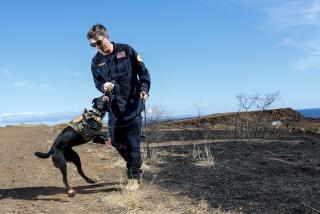For Sale: Monastery’s Saint Bernards
- Share via
GENEVA — Switzerland’s Saint Bernard, famous for rescuing avalanche victims in the Alps, is finally bowing its massive head, the fabled barrel around its neck replaced with a “for sale” sign.
Heavy and slow in the deep Alpine snow, the once-proud dogs are expensive to feed, obsolete and a drain on the resources of the religious order that has raised and trained them for centuries. Helicopters and heat sensors have largely supplanted the lumbering canines.
There is no record of when Saint Bernards first started rescuing people, but they are credited with saving some 2,000 travelers over the last 200 years.
With their usefulness at an end, however, the Congregation of Canons of the Great Saint Bernard is ready to sell the 18 adults and 16 pups.
An adult male can weigh up to 220 pounds and eat more than four pounds of meat a day. They also take up a lot of time and energy, says Brother Frederic, one of five monks living at the famous hospice on the pass.
“At first, and even at the beginning of the century, they were very useful,” Brother Frederic said. “But in 1955, there came the helicopter,” which had limited room for the large dogs.
By 1975, the last time one of the dogs was used on a mission, they had mostly been replaced at rescue scenes by smaller, speedier golden retrievers and German shepherds.
But the Saint Bernards remain the tourist’s best friend.
As their usefulness declined, the monks began to send the dogs to spend the winter in kennels down in the valley, first in Econe and now Martigny. During the summer tourist season, they were brought back up to the pass.
The dogs are expected to be sold to associations rather than individuals. The buyers will be required to let them return to the pass each summer.
“Nothing will really change when the dogs are sold, just the ownership,” Brother Frederic said. “It will take a load off of us and allow us to spend more time with those who need it. But the dogs will still be around.”
Monks founded the hospice at the summit of the pass -- 8,100 feet above sea level -- in the 11th century as a refuge for travelers. Large mountain dogs have been a part of hospice life since the mid-17th century, providing the brothers with company and protection as well as being deployed to rescue travelers lost in the fog and snow.
The Saint Bernard’s great stamina, extraordinary senses of smell and hearing, and double fur coat over a heavy layer of fat made it ideal for its job in the Alps.
The dogs saved numerous lives during Napoleon’s famous trek across the Great Pass in 1800. The St. Bernard’s fame subsequently spread throughout Europe and became the symbol of rescue and solace.
Barry, the most famous Saint Bernard, lived in the monastery from 1800 to 1812, helping save more than 40 people. To this day, at least one dog at the hospice is always called Barry in honor of the legendary canine.
Some parts of the dog’s heroic history may be more fable than fact.
The mythical barrel strapped around the dog’s neck and filled with brandy is not mentioned in the monastery records. It is, however, mentioned by the 17th century alpinist Reinhold Meissner, who wrote: “Often the dogs receive a little barrel around their neck with alcoholic beverages and a basket with bread.”
More to Read
Sign up for Essential California
The most important California stories and recommendations in your inbox every morning.
You may occasionally receive promotional content from the Los Angeles Times.










